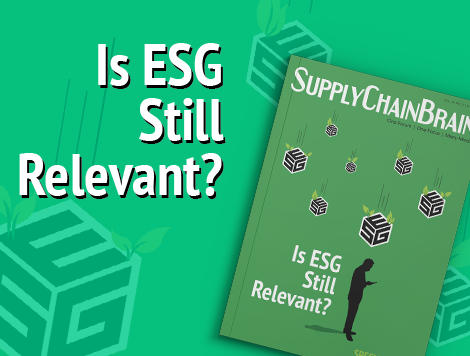
Visit Our Sponsors |
|
|
|
|
|
|
|
|
|
|
|
|
|
|
|
|
|
|
|
|
|
|
|
|
|
|
|
|
|
|
|
|
|
|
|
|
|
|

 Did you think we were going to say no?
Did you think we were going to say no?
To be sure, we’re seeing some pushback by the Trump administration against environmental regulation, as evidenced by its withdrawal (again) from the Paris Agreement on climate change. But don’t let that lure you into thinking that ESG — environmental, social and governance — is no longer a concern of international business. On the contrary, companies are pressing forward with efforts to reduce the impact of their global supply chains on our air, water, land and climate. Similarly, they’re demonstrating increased concern — whether out of the goodness of their hearts, or growing pressure from consumers; you decide — about human rights in factories, farms, mines and warehouses.
And so, in response to this reality, we’re back with our annual special issue on ESG in supply chains. Here, we invite dozens of industry experts to update us on the latest thinking about a topic that affects every step that products take, in their journey from design to raw materials, assembly, manufacturing, packaging, distribution, sale and, often, return.
No one here believes that ESG is yesterday’s news. Áine Clarke of the Business and Human Rights Resource Centre says diligence in that area “is non-negotiable.” And around the world, the regulations on ESG continue to pile up. (As of this writing, a pair of proposed European Union laws addressed here by some of our contributors — directives on due diligence and reporting on corporate sustainability — had been delayed by the European Parliament, but they’re sure to resurface at some point.)
The good news for business is that ESG compliance — whether voluntary or not— is more than just another regulatory burden. John McCaw of Breakthrough tells us that we don’t have to choose between sustainability and cost-awareness. Ty Colman of Optero says there’s a proven business case for emissions reporting. And Loren Johnson of Aravo says responsible sourcing paves the way for creation of “antifragile” supply chains. In fact, multiple contributors press home the point that active compliance equips companies with a competitive edge in global markets.
None of these initiatives will be cheap or easy to execute. A particular challenge, as discussed in several articles, is measuring and reporting on “Scope 3” emissions, as defined by the Greenhouse Gas Protocol, generated by one’s supply chain partners. Technology can help, especially with the rise of artificial intelligence as a means of analyzing vast amounts of data. But Constantine Limberakis of Liberis Consulting points to the difficulty of encapsulating all of “ESG” into one comprehensive tech suite. Multiple solutions will be needed to address what amounts to a massive, all-embracing mandate.
Nevertheless, global business is making the effort. Jamie Wallisch of Assent reports that nearly all of the manufacturers it surveyed are paying attention in some form to the need for sustainability and good governance. Meanwhile, says Jackson Wood of Descartes, countries in Asia are actively engaged in “future-proofing” their economies against a backdrop of ever-tightening environmental regulations. Supply chains need to do the same.
They’ll get a lot of expert guidance from the reports that follow in these pages. But the topic can’t possibly be contained in one annual issue. We’ll continue to cover it in detail with articles, videos and podcasts on a daily basis. Because ESG is — no spoiler alert required — relevant.
RELATED CONTENT
RELATED VIDEOS
Timely, incisive articles delivered directly to your inbox.






